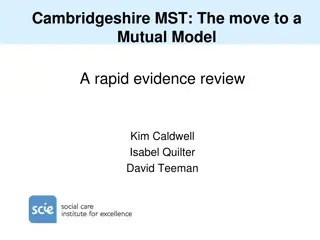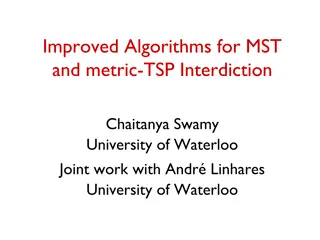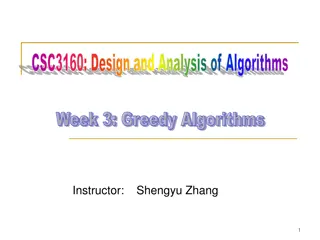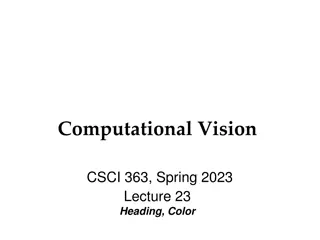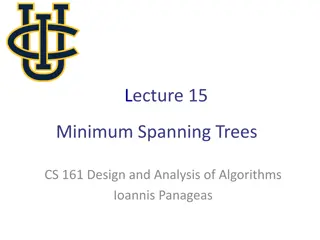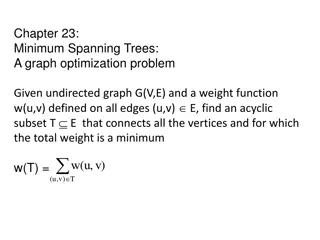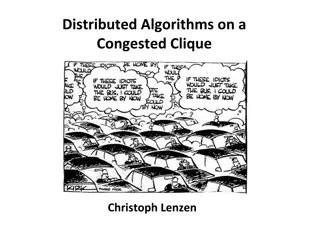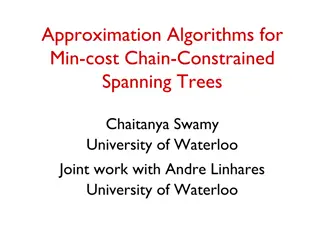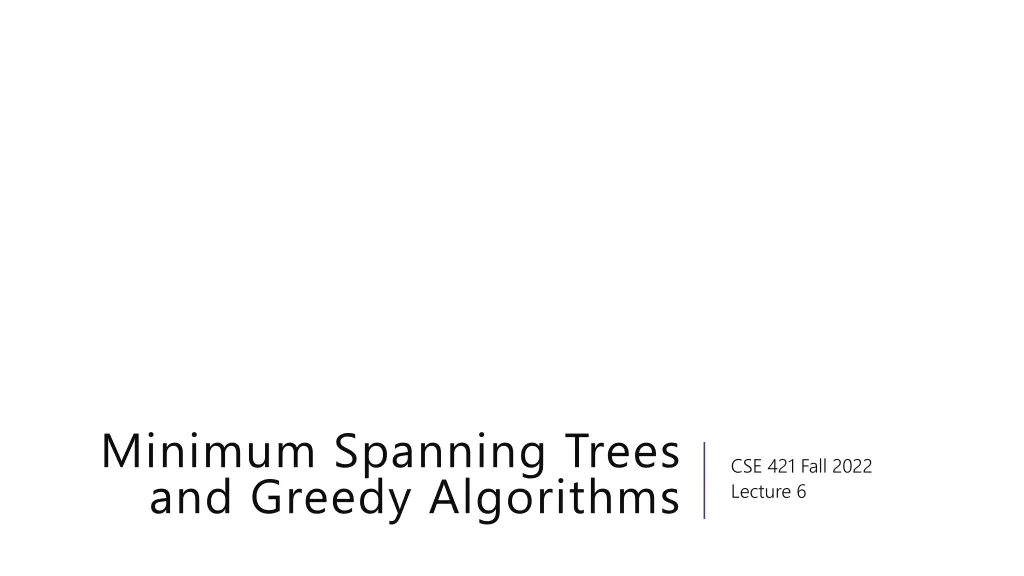
Understanding Greedy Algorithms | CSE 421 Fall 2022 Lecture 6
Explore the concept of greedy algorithms in CSE 421 Fall 2022 Lecture 6. Learn about their pros and cons, common proof styles, and applications in Minimum Spanning Trees. Discover how to approach new problems with a greedy mindset and be cautious when evaluating their effectiveness.
Download Presentation

Please find below an Image/Link to download the presentation.
The content on the website is provided AS IS for your information and personal use only. It may not be sold, licensed, or shared on other websites without obtaining consent from the author. If you encounter any issues during the download, it is possible that the publisher has removed the file from their server.
You are allowed to download the files provided on this website for personal or commercial use, subject to the condition that they are used lawfully. All files are the property of their respective owners.
The content on the website is provided AS IS for your information and personal use only. It may not be sold, licensed, or shared on other websites without obtaining consent from the author.
E N D
Presentation Transcript
Minimum Spanning Trees and Greedy Algorithms CSE 421 Fall 2022 Lecture 6
Announcements Remember that we always care about efficiency of algorithms. Unless we explicitly say otherwise: A slightly-less-efficient algorithm will receive slightly-less points. A significantly-less-efficient algorithm (like an exponential one) will receive significantly-less points. We don t care about constant factors.
This Week Another abrupt change of topic. In fact, the whole course is a sequence of seemingly-abrupt topic changes We re giving you a list of tools a list of common ways of thinking when approaching a new problem. Think of each week as a new tool in your toolbox.
Greedy Algorithms What s a greedy algorithm? An algorithm that builds a solution by: Considering objects one at a time, in some order Using a simple rule simple rule to decide on each object. Never goes back and changes its mind. order. Greedily Greedily do what looks best for you right here, right now.
Greedy Algorithms PROS Simple CONS Rarely correct Often multiple equally intuitive options Need to focus on proofs! Hard to prove correct Usually need a fancy structural result Or complicated proof by contradiction Or subtle proof by induction
Your Takeaways Greedy algorithms are great when they work. But it s hard to tell when they work the proofs are subtle. And you can often invent 2-3 different greedy algorithms; it s rare that 1 gives you the best answer, extremely rare that all would. So you have to be EXTREMELY careful. But they are very often useful when you need an answer that is very good, but not optimal (more on Friday).
Three Common Proof Styles Structural result the best solution must algorithm produces something that looks like this. Greedy stays ahead at every step of the algorithm, the greedy algorithm is at least as good as anything else could be. Exchange Contradiction proof, suppose we swapped in an element from the (hypothetical) better solution. must look like this, and the Where to start? With some greedy algorithms you ve already seen. Minimum Spanning Trees!
Minimum Spanning Trees It s the 1920 s. Your friend at the electric company needs to choose where to build wires to connect all these cities to the plant. B 6 3 E 2 1 C 10 A 9 5 7 4 D 8 She knows how much it would cost to lay electric wires between any pair of cities, and wants the cheapest way to make sure electricity from the plant to every city.
Minimum Spanning Trees What do we need? A set of edges such that: Every vertex touches at least one of the edges. (the edges span The graph on just those edges is connected The minimum weight set of edges that meet those conditions. span the graph) connected. Minimum Spanning Tree Problem Given: an undirected, weighted graph G Find: A minimum-weight set of edges such that you can get from any vertex of G to any other on only those edges.
Greedy MST algorithms You ve seen two algorithms for MSTs Kruskal s Algorithm Kruskal s Algorithm: Order Order: Sort the edges in increasing weight order Rule: Rule: If connect new vertices (doesn t form a cycle), add the edge. Prim s Algorithm: Prim s Algorithm: Order: Order: lightest weight edge that adds a new vertex to our current component Rule: Rule: Just add it!
Kruskals Algorithm KruskalMST(Graph G) initialize each vertex to be its own component sort the edges by weight foreach(edge (u, v) in sorted order){ if(u and v are in different components){ add (u,v) to the MST Update u and v to be in the same component } }
Try It Out B 6 3 E KruskalMST(Graph G) initialize each vertex to be its own component sort the edges by weight foreach(edge (u, v) in sorted order){ if(u and v are in different components){ add (u,v) to the MST Update u and v to be in the same component } } Edge Include? Reason (A,C) (C,E) (A,B) (A,D) (C,D) 2 1 C A 10 9 5 7 4 D F 8 Edge (cont.) (B,F) (D,E) (D,F) (E,F) (C,F) Inc? Reason
Try It Out B 6 3 E 2 KruskalMST(Graph G) initialize each vertex to be its own component sort the edges by weight foreach(edge (u, v) in sorted order){ if(u and v are in different components){ add (u,v) to the MST Update u and v to be in the same component } } Edge Include? Reason (A,C) Yes (C,E) Yes (A,B) Yes (A,D) Yes (C,D) No 1 C A 10 9 5 7 4 D F 8 Edge (cont.) (B,F) (D,E) (D,F) (E,F) (C,F) Inc? Yes No No No No Reason Cycle A,C,E,D,A Cycle A,D,F,B,A Cycle A,C,E,F,D,A Cycle C,A,B,F,C Cycle A,C,D,A
Prims Algorithm PrimMST(Graph G) initialize costToAdd to mark source as costToAdd 0 mark all vertices unprocessed, mark source as processed foreach(edge (source, v) ) { v.costToAdd = weight(source,v) v.bestEdge = (source,v) } while(there are unprocessed vertices){ let u be the cheapest to add unprocessed vertex add u.bestEdge to spanning tree foreach(edge (u,v) leaving u){ if(weight(u,v) < v.costToAdd AND v not processed){ v.costToAdd = weight(u,v) v.bestEdge = (u,v) } } mark u as processed }
50 G 6 Try it Out B E 2 3 4 C 5 PrimMST(Graph G) initialize costToAdd to mark source as costToAdd 0 mark all vertices unprocessed mark source as processed foreach(edge (source, v) ) { v.costToAdd = weight(source,v) v.bestEdge = (source,v) } while(there are unprocessed vertices) { let u be the cheapest unprocessed vertex add u.bestEdge to spanning tree foreach(edge (u,v) leaving u){ if(weight(u,v) < v.costToAdd AND v not processed){ v.costToAdd = weight(u,v) v.bestEdge = (u,v) } } mark u as processed } A 9 2 7 7 F D 8 Vertex costToAdd Best Edge Processed A B C D E F G
50 G 6 Try it Out B E 2 3 4 C 5 PrimMST(Graph G) initialize costToAdd to mark source as costToAdd 0 mark all vertices unprocessed mark source as processed foreach(edge (source, v) ) { v.costToAdd = weight(source,v) v.bestEdge = (source,v) } while(there are unprocessed vertices) { let u be the cheapest unprocessed vertex add u.bestEdge to spanning tree foreach(edge (u,v) leaving u){ if(weight(u,v) < v.costToAdd AND v not processed){ v.costToAdd = weight(u,v) v.bestEdge = (u,v) } } mark u as processed } A 9 2 7 7 F D 8 Vertex costToAdd Best Edge Processed A -- -- B 2 (A,B) C 4 (A,C) D 7 2 (A,D)(C,D) E 6 5 (B,E)(C,E) F 3 (B,F) G 50 (B,G) Yes Yes Yes Yes Yes Yes Yes
Correctness You re already familiar with the algorithms. We ll use this problem to practice the proof techniques. We ll do both structural structural and exchange exchange
Structural Proof For simplicity assume all edge weights are distinct and that there is only one minimum spanning tree. Structural result the best solution must algorithm produces something that looks like this. must look like this, and the Example: every spanning tree has ? 1 edges. So we better have our algorithm produce ? 1 edges. Is that enough? No! Lots of different trees (including non minimum ones) have ? 1 edges. Need to say which edges are in the tree.
Safe Edge A cut ?,? ? is a split of the vertices into a subset ? and the remaining vertices ? ?. 50 G 6 B 3 E 2 5 4 C A 9 2 7 7 F D ? = {?,?,?,?} 8 Edges in red span or cross the cut (go from ? to ? ?).
Safe Edge Call an edge, ?, a safe edge if there is some cut (?,? ?) where ? is the minimum edge spanning that cut (C,D) is a safe edge 50 G 50 G 6 B 3 6 E B 3 2 E 2 5 4 C 5 A 4 C 9 A 2 9 7 2 7 7 F D 7 F D 8 8 (A,B) is a safe edge
MSTs and Safe Edges Claim: Claim: Every safe edge is in the MST. Proof: Proof: Suppose, for the sake of contradiction, that ? = (?,?) is a safe edge, but not in the MST. Let (?,? ?) be a cut where ? is the minimum edge spanning (?,? ?). Let ? be the MST. The MST has (at least one) an edge ? that crosses the cut (since we can get from ? to ? in ? ) ? ? ? ? ?
Claim: Every safe edge is in the MST. MSTs and Safe Edges Add ?=(?,?) to ? . The new graph has a cycle including both ? and ? , The cycle exists because ? and ? were connected to each other in ? (since it was a spanning tree). Consider ? , which is ? with ? added and ? removed. ? ? ? ? ?
Claim: Every safe edge is in the MST. MSTs and Safe Edges Consider ? , which is ? with ? added and ? removed. ? spans: if the path from ? to ? in ? didn t use ? it still exists. If it did use ? , follow along the path to ? , along the cycle through ? to the other side. And it s a tree (it has ? 1 edges). What s its weight? Less than ? ; ? was the lightest edge spanning (?,? ?). That s a contradiction! ? was the minimum spanning tree. ? ? ? ? ?
Structural Result That s the structural result. ?is a safe edge if there is some cut (?,? ?) where ? is the minimum edge spanning that cut. Theorem: Every safe edge is in the MST. So what? The goal is to analyze an algorithm! Let s start with Prim s!
Prims only adds safe edges Claim: Claim: Prim s only adds safe edges. When we add an edge, we add the minimum weight one among those that span from the already connected vertices to the not-yet-connected ones. That s a cut! And that cut shows the edge we added is safe! Are we done? Do we know Prim s Algorithm is correct now? Not yet! What if there are still other edges to add!
Why Arent We Done? Imagine we define an ultra-safe edge as an edge that is lighter than every other edge in the graph. With a similar proof to our last one, you can show every ultra-safe edge is in the MST. Now imagine Brim s Algorithm: sort the edges by increasing weight, add the first edge in the sorted list. Brim s algorithm only adds ultra-safe edges! But that s not a correct MST algorithm!!!
Prims only adds safe edges Claim: Claim: Prim s only adds safe edges. When we add an edge, we add the minimum weight one among those that span from the already connected vertices to the not-yet-connected ones. That s a cut! And that cut shows the edge we added is safe! So we only add safe edges and we produce an acyclic, connected, spanning graph (since each edge must connect new vertices, we can t create a cycle; the loop ends only when the graph is connected). So we have a (full) spanning tree.
What about Kruskals? Exchange argument: General outline: Suppose, you didn t find the best one. Suppose there s a better MST Then there s something in the algorithm s solution that doesn t match OPT. (an edge that isn t a safe edge/that s heavier than it needs to be) Swap (exchange exchange) them, and finish the proof (arrive at a contradiction or show that your solution is equal in quality)!
Kruskals Proof (v1) Suppose, for the sake of contradiction, ??, the tree found by Kruskal s algorithm isn t a minimum spanning tree. Let ? be the true minimum spanning tree. Let ? = (?,?) be an edge in ?? but not ? . Add ? to ? . In doing so we created a cycle, ?, (? along with the path from ? to ? in ? , which exists because ? spanned.). Our goal is to do an exchange argument we need a new lighter tree! We divide into cases, Case 1: ? is not the heaviest edge in ?. Then delete the heaviest edge to create ? . Since ? replaced the heavier edge, ? is lighter than ? . And ? is a spanning tree (? has n-1 edges and spans because ? did and we just deleted an edge on a cycle). But that contradicts ? being the MST!
Kruskals Proof (v1, cont.) We won t be able to reach a contradiction from the cycle, but we will find another edge to examine Case 2: ? is the heaviest edge in ?. Since Kruskal s added ? to our graph, there must be some edge, ?, on the cycle which was not in ??. But ? was processed before ? by Kruskal s (since ? is heavier). Which means ? would have formed a cycle, ? in ?? had it been added when it was processed. By the process ordering, ? is the heaviest edge in ? . There are no cycles in ? (since it s a tree) so there is an edge (call it ? ) in ? that is not in ? . This new edge ? meets exactly the assumptions we had on ?, but is lighter. Repeat the original argument on ? . Since the graph is finite, we must eventually hit Case 1, which gives our needed contradiction.
Kruskals Proof (pretty version) Suppose, for the sake of contradiction, ??, the tree found by Kruskal s algorithm isn t a minimum spanning tree. Let ? be the true minimum spanning tree. Let ? = (?,?) be the lightest edge in ?? but not in ? . Add ? to ? , and we will create a cycle (because there is a way to get from ? to ? in ? by it being a spanning tree). ? is not the heaviest edge on the cycle. Anything lighter than ? is already in ??, and we put ? in ??so it didn t create a cycle there (since we check for cycles before adding it). That means there is an edge on the cycle heavier than ?. Delete that edge, and call the resulting graph ? . Observe that ? is a spanning tree (it has ? 1 edges, and spans all the same vertices ? did since we deleted an edge from a cycle). But it has less weight than ? which was supposed to be the MST. That s a contradiction!
HeyWait a minute Those arguments were pretty similar. They both used an exchange idea. The boundaries between the proof principles are a little blurry They re meant to be useful for you for thinking about where to start with a proof, not be a beautiful taxonomy of exactly what you do in every possible proof.
Another MST Algorithm Boruvka s Algorithm (also called Sollin s Algorithm) Start with empty graph, use BFS to find lightest edge leaving each component. Add ALL such edges found (they re all safe edges) Recurse until the graph is all one component (i.e. a tree) Consider it for your practical applications! It naturally parallelizes (unlike the other MST algorithms), Has same worst case running time as Prim s/Kruskal s!
Trip Planning Your goal is to follow a pre-set route from New York to Los Angeles. You can drive 500 miles in a day, but you need to make sure you can stop at a hotel every night (all possibilities premarked on your map) You d like to stop for the fewest number of nights possible what should you plan? Greedy: Go as far as you can every night. Is greedy optimal? Or is there some reason to stop short that might let you go further the next night?
Trip Planning Greedy works! Because greedy stays ahead Let ?? be the hotel you stop at on night ? in the greedy algorithm. Let ???? be the hotel you stop at in the optimal plan (the fewest nights plan). Claim: ?? is always at least as far along as ????. Intuition: Intuition: they start at the same point before day 1, and greedy goes as far as possible, so is ahead after day 1. And if greedy is ahead at the start of the day, it will continue to be ahead at the end of the day (since it goes as far as possible, and the distance you can go doesn t depend on where you start). Therefore it s always ahead. And so it uses at most the same number of days as all other solutions.
Trip Planning Greedy works! Because greedy stays ahead Let ?? be the hotel you stop at on night ? in the greedy algorithm. Let ???? be the hotel you stop at in the optimal plan (the fewest nights plan). Claim: ?? is always at least as far along as ????. Base Case: ? = 1, OPT and the algorithm choose between the same set of hotels (all at most 500 miles from the start), ?? is the farthest of those by the algorithm definition, so ?? is at least as far as ????.
Trip Planning Inductive Hypothesis: Suppose through the first ? hotels, ?? is farther along than ????. Inductive Step: When we select ??+1, we can choose any hotel within 500 miles of ??, since ?? is at least as far along as ???? everything less than 500 miles after ???? is also less than 500 miles after ??. Since we take the farthest along hotel, ??+1is at least as far along as ????+1.





